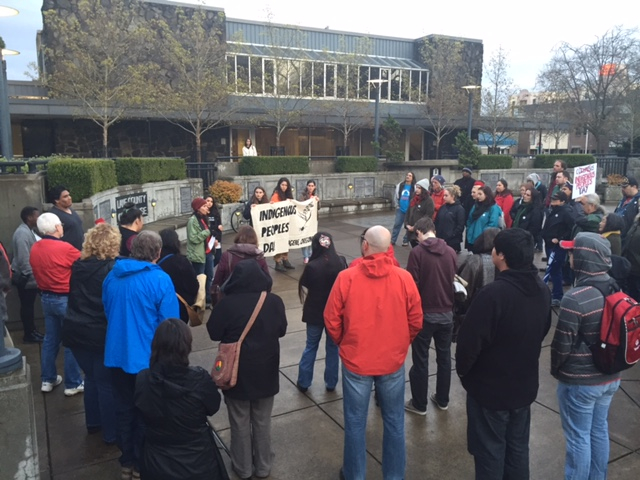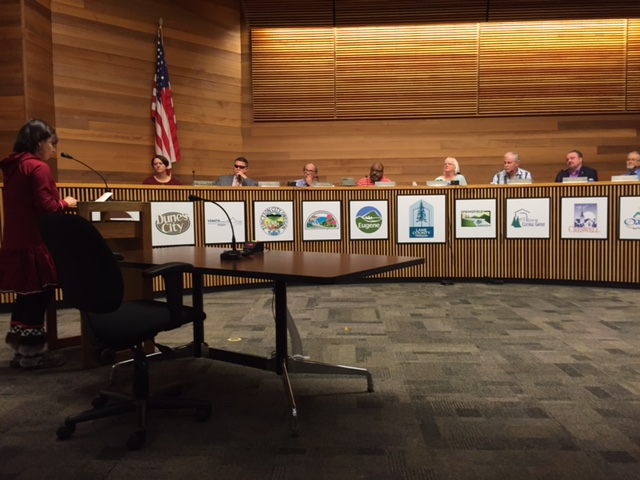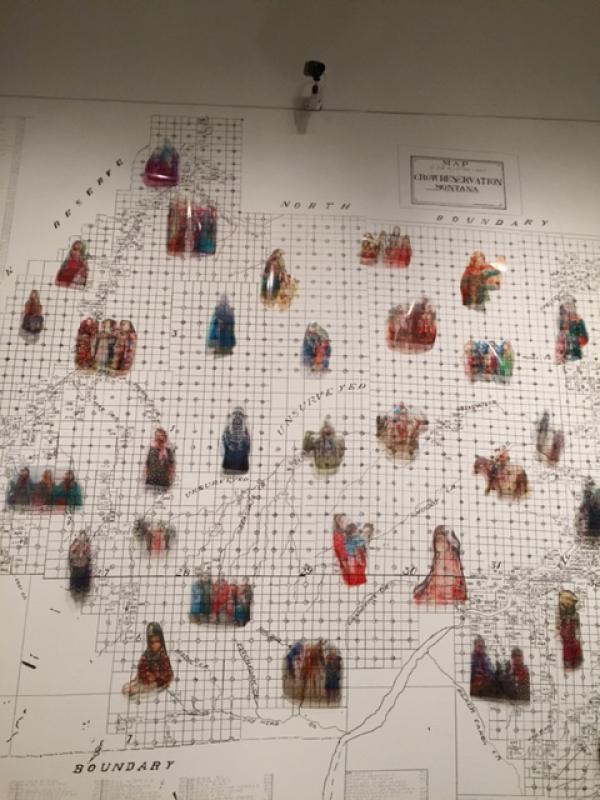

The UO Native American Student Union (NASU) led the charge at last night’s City Council Public Forum, making a final plea for the city of Eugene to pass a resolution to declare the second Monday of October as Indigenous Peoples’ Day. The council voted yes, joining other PNW cities Seattle, Portland and Corvallis.
Hear! Hear! It’s about time, and we hope to see cities around the country follow suit.
NASU held a rally outside Harris Hall before filling the hall to speak out on the ongoing struggle of indigenous peoples. The forum was a harrowing reminder of how far society — and our local community — has to go, from reparations to changing the narrative taught in schools of Christopher Columbus as the brave explorer who “discovered” the U.S.

Sigvanna Topkok (pictured above), a UO law student featured Jan. 28 in EW’s “Happening People” column, had the following to say to City Council:
“Growing up in the Oregon public school system, it became very clear to me at a very young age that my identity as an indigenous person did not have a face or was not very important in the American education system. Statistically speaking, I should not be here today; I should not even exist, because I was taught that natives lived only in the pages of our textbooks and were only spoken of in the past tense. I was taught that they once wore feathers, how they lived in teepees, never realizing that there were 567 federally recognized tribes, each with their own unique history and culture. Columbus Day is a harsh reminder of this and each year my teachers would explain how Columbus sailed the ocean blue and ventured forth into a new world, yet unsettled, at least by quote unquote civilized people. We were taught to celebrate this man and his bravery. Perhaps he was brave; I suppose it took a great deal of courage to embark on his journey aided by his dreams of silver and gold, and for better or worse he landed here in the Americas. But his behavior here set the tone for the next five centuries of the physical and cultural genocide of indigenous peoples. I was taught to celebrate this man, who saw indigenous men as subservient heathens, who encouraged the rape of indigenous women, who enslaved indigenous children and who wreaked havoc on indigenous lands.”
She added: “I seek to ensure that native children growing up in the public school system have a space to celebrate and to recognize their identity and cultural heritage.”
Another NASU student shared her experience as a resident of Eugene: “I had rocks thrown at my head on daily basis on my way to school. I was told that my hair was too long and that I needed to wash my skin because it’s too dark.”
She continued: “I hated going to school. When I tried to bring this up to school counselors, I was told to stop whining.”
If you’re interested in learning about the true story of Christopher Columbus, Indian Country’s “8 Myths and Atrocities About Christopher Columbus and Columbus Day” is a good primer, as is NPR’s 2011 broadcast “Think You Know The Real Christopher Columbus.”
Additionally, the Portland Art Museum currently has a beautiful exhibit challenging society’s narratives around indigenous peoples: Contemporary Native Photographers and the Edward Curtis Legacy, which runs through May 8 and is well worth the trip to Portland. The exhibit juxtaposes the work of contemporary native photographers Zig Jackson, Wendy Red Star and Will Wilson — gorgeous large-scale prints of everything from portraits of Native American veterans to shots of white American tourists taking pictures of Native Americans like they’re some sort of circus attraction — with the photography of Edward Curtis, whose early 20th-century images were supposed to capture the “noble savage” before white culture snuffed him out. It is a thought provoking, honest and, at times, grotesquely beautiful show. [Below, a piece from the exhibit.]
